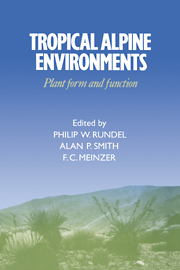Book contents
- Frontmatter
- Contents
- List of contributors
- Preface
- 1 Introduction to tropical alpine vegetation
- 2 Tropical alpine climates
- 3 Páramo microclimate and leaf thermal balance of Andean giant rosette plants
- 4 Comparative water relations of tropical alpine plants
- 5 Cold tolerance in tropical alpine plants
- 6 Anatomy of tropical alpine plants
- 7 Environmental biology of a tropical treeline species, Polylepis sericea
- 8 Morphological and physiological radiation in páramo Draba
- 9 Sediment-based carbon nutrition in tropical alpine Isoetes
- 10 Functional significance of inflorescence pubescence in tropical alpine species of Puya
- 11 Turnover and conservation of nutrients in the pachycaul Senecio keniodendron
- 12 Soil nutrient dynamics in East African alpine ecosystems
- 13 An overview of the reproductive biology of Espeletia (Asteraceae) in the Venezuelan Andes
- 14 Population biology of Mount Kenya lobelias
- 15 Population biology of Senecio keniodendron (Asteraceae), an Afroalpine giant rosette plant
- 16 Population dynamics and flowering in a Hawaiian alpine rosette plant, Argyroxiphium sandwicense
- 17 Plant form and function in alpine New Guinea
- 18 Alpine herbivory on Mount Kenya
- 19 Biotic interactions in Hawaiian high elevation ecosystems
- 20 Tropical alpine ecology: progress and priorities
- Index
18 - Alpine herbivory on Mount Kenya
Published online by Cambridge University Press: 21 October 2009
- Frontmatter
- Contents
- List of contributors
- Preface
- 1 Introduction to tropical alpine vegetation
- 2 Tropical alpine climates
- 3 Páramo microclimate and leaf thermal balance of Andean giant rosette plants
- 4 Comparative water relations of tropical alpine plants
- 5 Cold tolerance in tropical alpine plants
- 6 Anatomy of tropical alpine plants
- 7 Environmental biology of a tropical treeline species, Polylepis sericea
- 8 Morphological and physiological radiation in páramo Draba
- 9 Sediment-based carbon nutrition in tropical alpine Isoetes
- 10 Functional significance of inflorescence pubescence in tropical alpine species of Puya
- 11 Turnover and conservation of nutrients in the pachycaul Senecio keniodendron
- 12 Soil nutrient dynamics in East African alpine ecosystems
- 13 An overview of the reproductive biology of Espeletia (Asteraceae) in the Venezuelan Andes
- 14 Population biology of Mount Kenya lobelias
- 15 Population biology of Senecio keniodendron (Asteraceae), an Afroalpine giant rosette plant
- 16 Population dynamics and flowering in a Hawaiian alpine rosette plant, Argyroxiphium sandwicense
- 17 Plant form and function in alpine New Guinea
- 18 Alpine herbivory on Mount Kenya
- 19 Biotic interactions in Hawaiian high elevation ecosystems
- 20 Tropical alpine ecology: progress and priorities
- Index
Summary
Introduction
The savannas of East Africa, perhaps more than anywhere in the world, are known for dramatic plant–animal interactions. Although large herbivores are less common above timberline than below it in East Africa, herbivory is also a powerful force in Afroalpine plant ecology. Many vertebrates and invertebrate herbivore species occur above treeline on Mount Kenya (Moreau 1944; Coe 1967; Jabbal & Harmsen 1968; Coe & Foster 1972; Mulkey et al 1984; Young 1991; Young & Evans 1993). Herbivores influence the distribution of plant species, the size structure of populations, and the success of individual plants on Mount Kenya.
Long-term studies of giant rosette Lobelia and Senecio species have brought to light a number of interesting patterns of herbivory that have major impacts on the biology of these species.
Lobelia
The two high alpine giant rosette lobelias on Mount Kenya are Lobelia telekii and L. keniensis. Mount Kenya lobelias are subject to herbivory from a variety of animal species (Table 18.1). None of the herbivores is host-specific, except perhaps the coleopteran larvae associated with L. telekii roots. Most of these herbivores have only minor effects. However, Lobelia populations near hyrax colonies have suffered severe predation.
The leaves and stems of both Lobelia species are protected by a bitter latex containing anti-herbivore compounds (Mabberley 1975). Although this may limit the activity of their herbivores, it far from renders the plants invulnerable.
- Type
- Chapter
- Information
- Tropical Alpine EnvironmentsPlant Form and Function, pp. 319 - 336Publisher: Cambridge University PressPrint publication year: 1994
- 2
- Cited by



